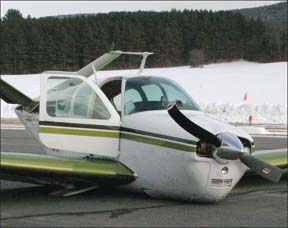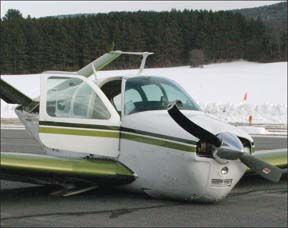
An Aviation Safety Staff Report
Just like the arguments over which is the better alternative between high-wing or low-wing, or choosing between tricycle gear and a taildragger, theres no simple answer to the question of when you should raise the gear after takeoff in a retractable gear airplane, or when you should lower it again for landing.
Things usually become widely accepted because they work, which would especially apply to the critical procedural sequences related to landing an airplane. However, very few, if any, can be considered sacrosanct and there are always other ways to do things.
When it comes to the takeoff, some say you should only retract the gear when you can no longer land on the runway; others insist the right time is when you have a positive rate of climb. As for when to lower it for landing, theres unconditional fact, theres subjective opinion and theres by the book. There is also common sense. Lets start at the takeoff.
What Goes Up…
One precept falling into the common sense category is not to rush things; in the case of an immediate engine failure, you wouldnt want to settle ignominiously back down on bent knees. This is particularly true for aircraft whose drag significantly increases during the retraction cycle, such as the Cessna 337 Skymaster, for which the correct procedure is to wait until the airplane is well-established in the climb.
As to facts, well, what do the airline pilots do? For the most part, they call for gear up after confirming a positive climb rate. Of course, an airline crew generally would have better training, better equipment, and more engines-and are probably incapable in most instances of landing on the remaining runway.
There are reasons for raising the gear immediately. First, once it is in the wells, climb performance improves. Another reason is that even if you live in Nebraska, the quicker you get to altitude, the more options you have if something goes wrong. If raising the gear gets you to pattern altitude 10 seconds sooner, that could mean another 150 feet, which just might mean the difference between making your emergency off-field landing site, making it back to the runway or not making it at all.
On the other hand, we can lay out one motivation against immediately raising the gear, too. Imagine lifting off from your 4200-foot runway, seeing a climb, raising the gear and-whoops-the door pops open. You forget you just raised the gear and congratulate yourself on your conservative plan to land back on the runway. After landing, you discover-forgive me for resurrecting this weary witticism yet again-that youre going to need an awful lot of power to taxi.
The reality is there are just too many variables for any one Golden Rule.At a short field, once you have Vx nailed, would you raise the gear before clearing obstacles if you thought it would help you clear them faster? Or is it unwise to be looking in the cockpit or reaching for flap and landing gear controls until obstacle clearance is assured? If taking off from a two-mile runway into a 200-foot overcast, would you raise the gear right away? Would you bother raising the gear at all, if you were only practicing crosswind landings in the pattern? Would you pull up the gear right away-or even cycle it-if you were taking off from a slushy runway?
The decision basically depends on the airplane: its gear system, performance numbers, and recommended procedures. Add to that the kind of runway and airport environment from which youre taking off, what kind of weather youre flying into, potential distractions, perhaps what your instructor drummed into your head…and maybe on which side of the bed your own landing gear first hit the floor that morning.
There are no universal procedures. The only collective credo is to keep thinking, know your options, know your airplane and use your checklists, but also use some common sense when you have to improvise.
…Must Come Down
Even though the space shuttle doesnt deploy its landing gear until seconds before landing, adopting such a procedure would probably make most pilots a little nervous. But depending on the circumstances, even our own well-established points for putting out the wheels might not be early enough.
In aviation, we like to avoid tight spots. For VFR approaches, we prefer to always check that gear extension is performed on every approach, and we usually dont wait until the last minute-we usually put the gear down somewhere between mid-field and abeam the numbers on downwind. In instrument conditions, we usually do it at the final approach fix or the glide-slope intercept. Both visual and instrument versions involve positional imprinting mentioned above. These two practices also achieve another goal, which is descent management. With the proper approach power, configuration and airspeed, just lowering the gear gives about a 500-fpm descent, allowing the balance of your time and workload for simply monitoring and fine-tuning.
Simply applying a conservative rule means-if youll pardon the irreverence-that premature extension can be a good thing. Lets say youre on an instrument approach and you have a situation where you are busier than usual, due to distractions. You might prefer confirming that the gear is actually down early and configure the airplanes pitch and trim so you can focus on other challenges.
One disadvantage to getting it out of the way sooner is that doing so can represent a significant change to your sequence of previously-established configurations and power levels, which might add at least a peripheral distraction to your existing workload (i.e., old habits are hard to break).You have to weigh that against the potential situations where you might be better off getting some of the work out of the way sooner, in order to spread it out a little. For an example of what I mean by a peripheral distraction, say you do put the gear down early on the inbound 45. You look at your airspeed a minute later, see it slower than you expected, and then realize Oh, yeah, thats right; the gear is down.
One benefit to getting the gear down sooner is having fewer things to deal with at the same time, should the gear not go down as expected. Theres nothing absolutely wrong or incorrect about the way you were probably taught.The basic concept here is to minimize any potential complications. Wouldnt you rather find out about a gear problem before you were in a busy pattern, or approach corridor, or during the busiest phase of an instrument approach?If there were a problem, would you not prefer having more time to deal with it?
Breaking The Pattern
No matter what our habit is, there will come a time when something distracts us. We can build in a defense mechanism-like motoring into the airport environment above the airplanes gear extention and needing to slow down to drop the gear and slow down further to enter the pattern-or slavishly adhere to a checklist or flow pattern. Performing multiple pre-landing checks is another way, as is adopting the habit of saying aloud, Were ready to land.
The thing is, were human, we easily forget things, and we make mistakes.It only gets worse when we get busy. Its one thing to forget the milk you were supposed to buy at the grocery store; its something else to forget the very thing around which we have supposedly ingrained expectations and a time-honored process: lowering the gear.
Gear Emergencies
Of course, when turbulence is involved, its often better to get the gear down to expedite the process of slowing below maneuvering speed.And then there are the times the gear wont come down at all. Surely, were not in the flare when we discover this, but the key is knowing something about your airplanes landing gear system beyond where the handle is.
There are several different types of gear extension systems, a few of which are summarized in the sidebar below. With manual gear extension systems, there are no hydraulic lines, no wires; theres just a lever to shove. Pneumatic systems are uncommon, but have simple backups. Electro-mechanical systems dont need hydraulic fluid, but absolutely depend on the other kind of juice. And hydraulic systems demand during any emergency extension scenario in a high-workload situation (such as single-pilot IFR) could head- and hand-turning, manipulating an inconveniently located crank a few dozen times, while you fly an approach in IMC. Electro-hydraulic systems need both electricity and hydraulic fluid.
Here, a loss of hydraulic fluid will actually result in the gear extending, whereas a Cessnas must extend forward against the slipstream, and absolutely requires a hand pump (which only works if the hydraulic system does). Here too, if youve gotten in deep enough, landing gear-up may realistically be your only safe option.
In visual conditions, you simply exit the pattern, go somewhere quiet to troubleshoot and run through the emergency gear extension procedure. In IMC, however, it gets more interesting. If you lower the gear at the Initial Approach Fix instead, and theres a problem, you can forget about having to track an approach course. Would you rather add troubleshooting the gear to your cockpit procedures during an approach?
Putting It All Together
True, by getting the gear down early you pass up that traditional imprinting point, and by forsaking the usual gear down, go down times youll have to use some other method of introducing a first approximation for your desired rate of descent (such as reducing power by three inches of manifold pressure or by 300 rpm). And of course, it will take you longer to get there. And in the vast majority of cases, while youre coming in more slowly, whether thats just a 45 to the downwind, from the IAF (or even if you dont extend the gear until the outbound leg on the approach), is the cost of a few extra minutes of flying time worth it for single pilot IFR, or peace of mind? It might be.
Also With This Article
“Whats In Your POH?”
“Know Your Gear”




